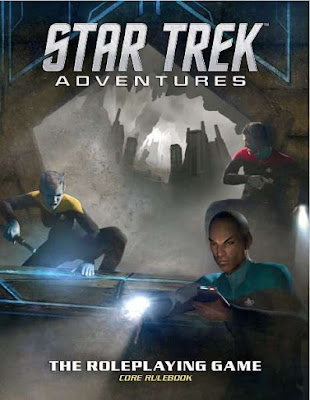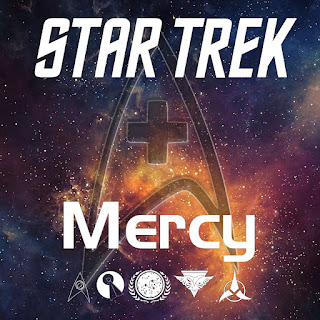1974 is an important year for the gaming hobby. It is the year that Dungeons & Dragons was introduced, the original RPG from which all other RPGs would ultimately be derived and the original RPG from which so many computer games would draw for their inspiration. It is fitting that the current owner of the game, Wizards of the Coast, released the new version, Dungeons & Dragons, Fifth Edition, in the year of the game’s fortieth anniversary. To celebrate this, Reviews from R’lyeh will be running a series of reviews from the hobby’s anniversary years, thus there will be reviews from 1974, from 1984, from 1994, and from 2004—the thirtieth, twentieth, and tenth anniversaries of the titles. These will be retrospectives, in each case an opportunity to re-appraise interesting titles and true classics decades on from the year of their original release.
—oOo—

Published by
Fantasy Games Unlimited in 1981,
Merc: A modern Roleplaying Game of Counter Insurgency was one of the first military themed roleplaying games. It had been preceded by
The Morrow Project from Timeline, Ltd., although that was a post-apocalypse roleplaying game, and would be followed by FASA’s
Behind Enemy Lines and Role Playing Games, Inc.’s
Recon: The Roleplaying Game of the Viet Nam War, both in 1982. The genre would arguably reach its apotheosis in 1984 with the release of
Twilight 2000 from GDW. Of course, the earlier
Traveller Book 4: Mercenary from 1978 from GDW would cover some of the same subjects and situations as
Merc, but being a Science Fiction roleplaying game, it would avoid some of the real-world issues that
Merc deals with. What is interesting about the titles in this genre is not that they were published at all, but rather that it took so long for the roleplaying industry to publish straight, non-fantastical treatments of military subjects given that hobby had essentially come out of the wargaming hobby and that many of its designers and players had military experience.
The designers of
Merc set out their stall with, “Think of the possibilities: go back to 1954 and go on patrols with the Legion in Indo-China, or search the countryside of Ireland for I.R.A. terrorists, join 5 Commando in 1964, or even lead a patrol of Soviet 103 Guard Army Airborne into Afghan hill country. With these rules and your imagination you can visit Rhodesia, Chad, Angola, El Salvador, Panama, or even Cuba. Of course, your accommodations won’t be first class and you’ll have people shooting at you, but we guarantee lots of excitement.” Thus,
Merc is a role-playing game of modern mercenaries in action, carrying out missions for their employers anywhere in the world, being employed as Soldier of Fortunes operating in small teams. Missions will be covert or overt, and range from assassinations and search and destroy to sweeps and reconnaissance.
Merc comes as a boxed set, which contains a thirty-six-page book, four cardstock reference sheets, plastic transparent overlay, and two six-sided dice. The book covers character creation, including former service and why the Player Character decided to become a mercenary, rules for movement and stealth, small arms combat, vehicles, experience, and a short mission. The reference sheets reprint various tables from the book, whilst the plastic transparent overlay has a target which is placed over the silhouettes of vehicles and men on the other reference sheets and the hit location rolled for. This is likely one of the first uses of a transparent overlay in a roleplaying game, and would most notably be seen again in 1991’s
Millennium’s End from Chameleon Eclectic Entertainment and 2007’s
Aces & Eights: Shattered Frontier from Kenzer & Company.
A Player Character in
Merc is defined by his Physical Appearance, Physical and Mental Attributes—Strength, Agility, Intelligence, Knowledge, Intuition, and Prior Military Service, and one or more Military Specialities. The latter two will be defined by a mercanary’s Physical and Mental Attributes. Physical Appearance values are rolled on three six-sided dice. All Physical and Mental Attributes are measured as percentile values, but range from eleven to sixty-six. These are all generated by rolling two six-sided dice and treating one as the tens dice and the other as the ones dice, again one of the earliest uses of the ‘d66’ in a roleplaying game. The process is relatively straightforward and a player is free to assign the rolls to the attributes as he likes, primarily to be able to select the ‘Military Occupational Specialty’ of his choice.
Name: Ernest LuddeAge: 31Height: 5’ 9”Weight: 170 lbs.
Hair Colour: BlackEye Colour: BrownComplexion: AverageVoice: AverageHandedness: Ambidextrous
ATTRIBUTESStrength 62 – Strong (+5 Test Modifier)Agility 63 – Nimble (+5 Test Modifier)Intelligence 24 – AverageKnowledge 54 – Knowledgeable (+10 Test Modifier)Intuition 61 – Primordial (+5 Test Modifier)Prior Military Service 44 – Extended Service (+10 Test Modifier)
MOS #1: Heavy Weapons ExpertMOS #2: Martial Arts Expert
Frame: MediumCarrying Capacity/Build: Above Average (125 lbs.)
MAJOR TESTSStress Test: 46Dexterity Test: 46Command Control: 51
Mechanically,
Merc uses two core mechanics. The first is Major Tests, of which there are three—Stress, Dexterity, and Command Tests. The first is rolled when a Player Character is in a tight situation, under sniper fire, in a minefield, and so on, and can result in him freezing, bolting for cover, or blindly opening fire. The second covers acts of agility and athleticism, whilst the third is how well troops follow a Player Character’s command. All are rolled as percentiles on ‘d66’, the aim being to roll under. The second type of test is the Skill test, and there are nine of them—Detection, Evasion, Pathfinder, Stealth, Intercept Messages, Decipher, Concealment, Set/Disarm Explosive Devices or Traps, and Set/Disarm Non-Explosive Devices or Traps. All are rolled on two six-sided dice, the aim being to roll under a target of six or less, though this target can be modified by the situation and the Merc’s Primary and Secondary MOS.
As a military game,
Merc recommends that it be played using 20 mm miniatures. It covers just about everything you would expect—types of movement, terrain, vehicles, types of opponents, combat, ambush, traps, and equipment. Movement is by type, cross-referenced with terrain and how far a mercenary can get in thirty seconds. The vehicles tend to be light and relatively small, so trucks and jeeps, no more than armoured personnel carriers, scout cars, and light tanks, plus limousines and private jets. Opponents include government troops, terrorists, guerrillas, and natives. The list of equipment is exactly that, and anyone expecting something more complex or detailed is likely to be disappointed. Combat uses three different mechanics. Unarmed combat is a standard Skill Test, as are use of grenades and mortars, though with higher targets. Small arms fire though, is rolled on three six-sided dice, the aim being to roll under a target of twelve or less, though this target can be modified by the situation. Sniper shots use the transparent overlay placed over a silhouette. Two six-sided dice are rolled, modifiers are applied, and the result compared to the number on the transparent overlay. The aim is to roll as low as possible to get closer to the aim point. Rolls of zero or below are considered to be on target.
There is not a huge amount of depth to
Merc, but damage is where it definitely feels underwritten. Located in the section for the Corporation—the name for the Referee in
Merc, and also the employer for the teams of the Player Character mercenaries—it is handled on a single table which with a roll or two, determines hit location, severity and damage inflicted, and effect. Typically, this includes the initial damage, the ongoing damage, and whether or not the damage inflicted is a mortal wound. There is no effect from skill or weapon type as such. The rules also state that Body Points are lost, when in fact they are not. Rather they are gained, whether from the initial damage, from wounds, and ongoing damage, such as internal bleeding. As a mercenary gains more, the greater the chance of his falling unconscious or dying from his wounds. Similarly, the rules for medical care are also underwritten and undeveloped.
Also, for the Corporation, there is a guide to mission types and how many Experience Points a mercenary will earn from successfully completing it. A mercenary will earn more if his MOS is pertinent to the mission and he performed it well, so a medic will earn more for keeping a hostage already known to be seriously wounded, alive long enough to bring him back after being rescued. Experience Points are then divided in two, one half being paid as money to the mercenary and the other awarded as actual Experience Points, and these are split between Attributes and MOS. Exactly how that works is not quite fully explained. Ultimately, should a mercenary acquire enough Experience Points, he is hired by the corporation and retires.
The Corporation is provided with an example of play, which is definitely of use when trying to understand the rules and how the game is meant to be played. There is also a scenario set in Rhodesia in 1975. The Player Characters are mercenaries hired by the White minority government to strike at a village harbouring ‘terrorists’ who have crossed the border with Zambia and begun operating in the area. It comes with a couple of maps and six pre-generated mercenaries. There is a distinct anti-Communist tone to some of them and in comparison, to the pre-generated mercenaries, the scenario does not even name any of the terrorists, give them any personalities or motivations, or backgrounds—and the villagers are ignored all together. The orders for mercenaries are to eliminate the terrorists—and if necessary, the village. Much more of a wargaming than a roleplaying scenario, would anyone really want to roleplay such a mission? There is no denying the historicity of the situation, but that does not make it any less abhorrent.
—oOo—
It would be at least a year before
Merc: A modern Roleplaying Game of Counter Insurgency was reviewed at the time of its release. In the January 1983 edition of
The Space Gamer (No. 59), Brian R. Train thought that the game suffered from a lot of ambiguous rules, saying, “This is quite a good game for an (assumed) first effort – I feel its flaws are due basically to not enough development time and design limits. If a later, revised edition of Merc were put out, I would heartily recommend it. As it is, though, I would warn the buyer to ‘approach with caution’ unless he is already quite familiar with the subject matter, in order to fill in the numerous holes.”
Paul Cockburn gave
Merc only a thumbnail review in
Imagine No. 9 (December 1983), alongside reviews of other Fantasy Games Unlimited titles—
Daredevils,
Daredevil Adventures, Vol 2, No. 1 & 2,
Merc Supplement 1, and
Swords & Sorcery for
Chivalry & Sorcery. He wrote, “Merc is clearly designed for the gun nut, the sort of role-player who likes to know just how much of a mess his assault rifle will make of a ‘soft’ target.” before concluding “The book is dedicated to ‘Mad’ Mike Hoare, (Mercenary Extraordinaire)—and I’m sure he’ll be delighted.” In comparison, William A. Barton, writing in
Different Worlds Issue 32 (Jan/Feb 1984), gave Merc and its first supplement a more detailed review, in the process identifying several issues with the rules which felt should have been caught in the editing and playtesting stages. He stated that, “If the thought of going into corporate employ for combat missions in third-word countries on a regular basis is appealing to you—or if you desperately need additional information to bolster campaigns based on systems such as Traveller’s Mercenary, which lacks data on most of the situations covered by Merc—FGU’s little game of modern counter-insurgency situations might not prove a bad buy for you at all.” However, he thought that the price was “…[j]ust a bit steep for those not thoroughly committed to modern merc role-playing.”
—oOo—
When it was published in 1981,
Merc: A modern Roleplaying Game of Counter Insurgency was a very contemporary roleplaying. After all,
Colonel ‘Mad’ Mike Hoare would attempt a coup d’état in the Seychelles in November of that year, the film
The Wild Geese and the book it was based upon appeared in 1978, and
The Dogs of War, the film based upon the book by Frederick Forsyth, had been released the year before. The concept of mercenaries conducting small unit operations in faraway countries was common, and as Soldiers of Fortune, such men were revered and reviled in equal measure. It is rare that a roleplaying game can be or would be as contemporary. Forty years on, and both
Merc and the world it depicts are very much a piece of history—and a troublesome one at that. Today, mercenary work has been corporatised as security work and is rarely in the news as it was then, but the world of
Merc is one of post-colonial intervention, even meddling, in Third World countries, and it feels, and is, distasteful. As is mention of the fact that mercenaries served with the Nazis in World War II, as is having to determine height, weight, build, and so on, according to ethnicity, as is the scenario being set in Rhodesia (now Zimbabwe) and being employed by the White government to prevent ‘terrorists’ sneaking over the Zambian border and attacking the railway. This was the situation in Rhodesia, but having to roleplay that now as well as the other elements, means that it is horribly dated, and feels at least horribly inappropriate, if not actually racist. And that is not even mentioning that all of the Player Characters are meant to be male. Of course, it depicts what was a male world, but again, it feels unintentionally misogynist.
In some ways more a military skirmish wargame than a roleplaying game,
Merc: A modern Roleplaying Game of Counter Insurgency has not dated well in the forty years since it was originally published. At best, it showcases why sometimes the contemporary is not always the best realm for a roleplaying game to be exploring. It might be serviceable for what it is, and arguably not even that in some places, but the world it depicts and what it involves the Player Characters doing is most definitely a different country, and beyond its limited historical significance as a roleplaying game, perhaps
Merc: A modern Roleplaying Game of Counter Insurgency should stay there.
 It's the start of May! Let's begin the new month like I have been doing all year long so far with a new character.
It's the start of May! Let's begin the new month like I have been doing all year long so far with a new character.




























